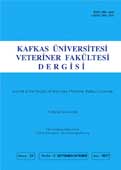
This journal is licensed under a Creative Commons Attribution-NonCommercial 4.0 International License
Kafkas Üniversitesi Veteriner Fakültesi Dergisi
2017 , Vol 23 , Issue 5
Effects of Birth Type on Growth, Fattening Performance and Carcass Characteristics in Honamlı Male Kids
1Department of Animal Science, Faculty of Veterinary Medicine, Mehmet Akif Ersoy University, TR-15030 Istiklal Campus, Burdur - TURKEY
DOI :
10.9775/kvfd.2017.17703
The aim of this study is to determine fattening performance, slaughter and carcass characteristics of single and twin male Honamlı kids raised
under semi- intensive conditions. In the study, 90 day-olds (weaned at the age of 75 days and the 15-day period of adaptation to feeding),
10 single and 10 twin Honamlı male kids were fattened for 56 days and all kids were sent for slaughter at the end of the fattening period.
Final average live weights were found to be 34.4 kg and 30.4 kg for single and twin kids. Average daily live weight gain during fattening was
203 g for single kids and 231 g for twin kids. Hot carcass weights obtained after slaughter were 14.47 kg and 12.43 kg; dressing percentages
calculated based on empty body weight were determined to be 52.46% and 51.11% for single and twin kids, respectively (P>0.05). Cold
carcass weights were determined to be 14.19 kg and 11.17 kg for single and twin kids, respectively; cold carcass yields calculated based on
empty body weight were determined to be 51.53% and 50.04% for single and twin kids. The surface areas of M. longissimus dorsi (MLD) were
found to be 13.39 cm2 and 12.43 cm2, respectively. Withers height, rump height, body length, chest girth, and nose length of single kids were
relatively higher compared to twin kids at the end of the fattening period.
Keywords :
Honamlı male kids, Type of birth, Fattening, Slaughter, Carcass










